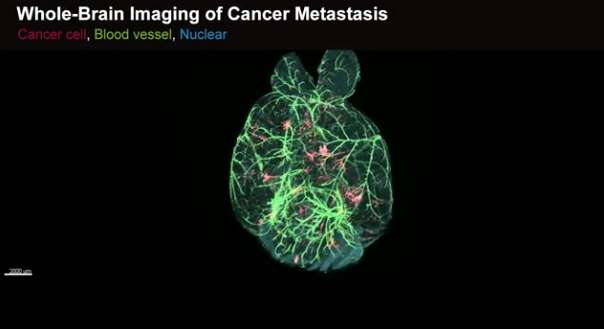Watch cancer spread in a mouse

Researchers in Japan have developed a method to image cancer at the single-cell level by using chemical techniques to make whole mouse bodies and organs highly transparent. Combining their preparation with existing imaging technology, they were able view cancer cells multiplying within organs, including the lungs, intestines, and liver, and traveling through the body to and from new tumors in distant locales. The work appears July 5 in Cell Reports.
"The study demonstrates the power of whole-body and whole-organ clearing and imaging with single-cell resolution," says co-corresponding author Hiroki Ueda (@hiroking1975), of the University of Tokyo and the RIKEN Quantitative Biology Center. The research team achieved single-cell resolution for cancer models that grow and metastasize in different ways. The images reveal cancerous colonies in enough detail to calculate their shapes, volumes, and distributions—characteristics critical to distinguishing between patterns of metastasis.
For example, the researchers used the platform to generate a whole-mouse scan of pancreatic cells spreading into the liver and throughout the abdomen. Another set of images shows a healthy pair of lungs being gradually colonized by cancer cells over the course of two weeks, while a third probes relationships between cancer cells and blood vessels inside the brain.
Picturing individual cancer cells during metastasis is challenging because they can be scattered all over an entire body. Locating the cancer cells relies on picking up signals from fluorescent proteins that they express, signals that must be preserved when applying tissue clearing methods in pursuit of higher resolution.
Given this difficulty, the research team, which included co-first authors postdoc Shimpei Kubota and project researcher Kei Takahashi, took a chemical mixture called CUBIC (Clear Unobstructed Brain/Body Imaging Cocktail) that they had previously developed for whole-body imaging preparation and optimized its composition for detecting and viewing cancer cells. Upon using the modified mixture to turn tissues and vital organs clear, the researchers were able to pluck out fluorescence signals and locate cancer cells in places such as the liver, pancreas, and intestines.
The new imaging protocol is already providing a clearer view of certain mysterious steps of metastasis. In particular, in order to reach a new site within the body and metastasize, a cancer cell must surf the bloodstream, entering and exiting through blood vessel walls.
"Most cancer cells are not so lucky and die during the trip," says co-corresponding author Kohei Miyazono, of the University of Tokyo, "But images obtained through the new method suggest that cells treated with TGF-beta, a protein that regulates cellular growth and differentiation in humans and is produced in increased quantities by some cancers, are far more likely to survive the journey and form malignant outposts."
With preliminary investigations already underway, the researchers say that cancer imaging and analysis using the CUBIC protocol will lead to further insight into the complexities and nuances of metastatic pathways. The technique might also shed light on single-cell processes related to other diseases or medical fields. "We believe that same strategy will be applicable to other biomedical studies such as autoimmunity and regenerative medicine, in which the single-cell events play crucial roles," says Ueda.
More information: Cell Reports, Kubota et al.: "Whole-body profiling of cancer metastasis with single-cell resolution" www.cell.com/cell-reports/full … 2211-1247(17)30806-9 , DOI: 10.1016/j.celrep.2017.06.010




















